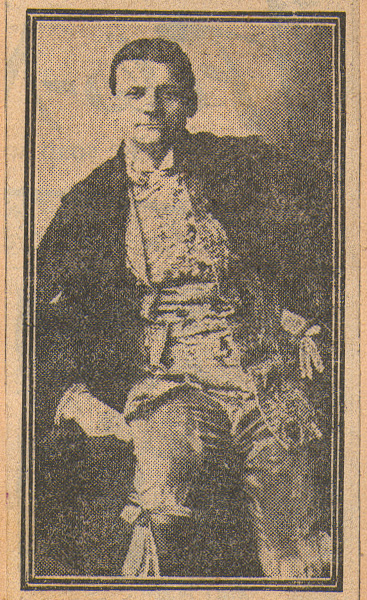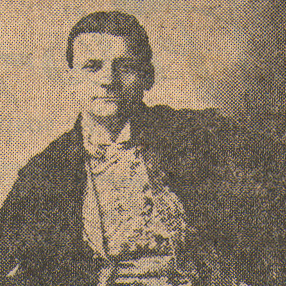TEN PERSONS PERISH IN THE FLAMES OF A BURNING MUSIC-HALL IN EDINBURGH
TRAGIC FATE OF A GREAT ILLUSIONIST
By a terrible fire that broke out in the Edinburgh Empire Palace Theatre the other night the stage in the course of a few minutes was converted into a veritable furnace, shutting off the escape of ten persons who perished in the flames. Among the victims was Lafayette, the “Great Illusionist and Man of Mystery,” whose performance constituted the “star turn.”
At the time of the outbreak, which was nearing the end of the second house, Lafayette and his staff, consisting of over twenty men and women, and, in addition, two animals – a lion and a horse-occupied the stage, the subject of the scene being “The Lion’s Bride” a most sensational illusion, which is presented with the barbaric splendour of the East. With startling suddenness a great mass of flames rose from amidst the superb staging, and was carried by the draught right across the footlights towards the stalls. The audience for a moment thought it was part of the performance, but they were soon undeceived when they saw that the stage was on fire. No sooner did the stage manager observe the alarming state of affairs then he gave orders for the dropping of the fireproof curtain. Before the curtain could be lowered flames were consuming the light scenery on the stage, and were being driven outwards into the auditorium over the heads of the members of the orchestra. At this point a man rushed to the front of the stage, and, addressing the crowded house, counselled the people to go quietly away.

There was no panic, and although great anxiety prevailed, the audience, number about 3000 men, women, and children, made their escape from the building in comparatively orderly fashion.
On the stage itself the confusion could not have been otherwise than great. In addition to Lafayette and his assistants there was the numerous staff of the theatre. So rapidly did the fire gain ascendency that they had to make their escape, each one practically having to look out for him-self. Several of Lafayette’s assistants, in their quaint costumes, made their way to the street in safety. They had, however, to leave behind them the whole of the elaborate effects used in the performance, and these, and the effects of the other numerous artistes, both personal and professional, were soon involved in the flames, which shot from the stage as from the blazing furnace.
An “alarm parade” of the Territorial’s was just concluding when the lurid reflection
in the sky announced that some large building was on fire, and immediately the men set off at the double to the end of the Potterrow and to Nicolson Street, where the front entrance of the building is situated. Already the fire brigade and a strong force of police were present, and their numbers were immediately strengthened by hundreds of young Territorials, who with linked rifles kept the crowd in check, although there were ugly rushes on the part of the rougher element in the gathering. The Territorials formed a strong guard in Nicolson Street, and barred the way to College Street, allowing the firemen free play, while the same manoeuvre was carried out at the entrance to Potterrow. The combined efforts of the firemen, who attacked the flames vigorously, at length began to have their effect, although dense volumes of smoke, accompanied by showers of sparks, were thrown on the building.
By midnight the fire was well in check, by which time the whole of the stage was gutted. The auditorium practically escaped damage. About two o’clock in the morning a search of the debris brought to light the fact that at least five persons had perished, among those being Alice Dale, the little girl who played the part of Teddy Bear in Lafayette’s performance. The body of James Bayne, who was also one of the troupe, was discovered along with three others, who at that time could not be identified. At first it was though that these were the only victims and that Lafayette himself had escaped. Unhappily, as subsequent investigations proved, the death-toll not only included Lafayette, but other four persons, making ten in all. It is the belief of eye-witnesses that Lafayette could have made his escape from the burning building, but that, neglected his chances of safety, he heroically endeavoured to save the lives of his company, and also a valuable mare to which he was greatly attached. One of the most distressing incidents of the fire consisted of the burning of the lion, which was used by Lafayette in one of the items of his performance. The suddenness with which the flames spread in the vicinity of the stage made it impossible to take measures for the removal of the animal.
Most of the bodies were recovered in a corner of the stage, to which the victims appear to have fled from the flames which gradually enveloped them. It is supposed that they were suffocated by the dense smoke before the fire reached them. The names of the dead are:- Joseph Coates, “the midget” (14), Sheffield. He had joined the company within the last fortnight; Alice Dale (17), “the Teddy Bear” in Lafayette’s company (address: New Inn, Hammond Street, Sheffield); John Whellan , (40), trombone player in Lafayette’s company, a native of London; James. E. Baines (45), double bass player with Lafayette, Hackney, London (married); Walter. E. Scott, said to be a cornet player, also with Lafayette. The police have three bodies. One is Lafayette which was identified by his manager, and the other two supposed to be those of the big drummer in Lafayette’s company, and a stage flyman, both of whom are reported missing. Several of the employees received injuries in the course of the fire, the most serious being: Robert Nelson, 115 Buccleuch Street, who is suffering from burns on the face and legs, and slight shock. The others are:- Charles Munro, Gilford Park, suffocation and shock; Thomas Haig, Boroughloch Square, suffocation and excitement; Harry Moore Willowbrue Road, shock. These are detained at the Infirmary, while fireman Kendall had one of his hands badly cut and had to get six stitches put in at the infirmary.
With regard to the cause of the outbreak a stage employee stated that Lafayette was just about to close his performance when “a ball of fire” fell from above and in a moment the scenery was blazing furiously.
At once there was a wild stampede by the artists who were on the stage and it was thought that they and all the stage hands had got safely out of the building. Though the theatre was crowded the audience left the building in good order. Particularly commendable was the conduct of the occupants of the gallery, who marched downstairs without undue crushing. Some women who had been in the pit had to be assisted out of the building in a half-fainting condition. A member of the audience, Mr. M. Jenkinson, who has been in the gallery stated in an interview that at one time an ugly panic in the staircase leading from the gallery seemed imminent. A rush was made when the alarm was raised, and he and a number of others around him were carried down the stairs. Screams were heard in all directions, and above the din could be heard the cries of a women who had fallen, and was being trampled upon by the crowd behind. Mr. Jenkinson found himself in her vicinity. Catching hold the railing behind him he held on tenaciously, and was able to divert the outgoing stream past her sufficiently to enable him to lift her up. When this had been accomplished, he and others carried her outside. There was numerous cases of women and girls fainting, and in several instances men who had been in the gallery managed to get them on their shoulders and carry them to safety. The scene for a time was of a most distracting character.
The acting manager at the theatre Mr. C. B. Fountaine, said, in the course of an interview, he was in the front just prior to the fall of the curtain, when he perceived a little spurt of flame, which he knew had no part in the performance. He rushed round to the stage, which he reached just as the stage manager operated the lever which controlled the iron curtain. Mr. Fountaine hastened to the front and shouted to the conductor, “The King,” and the orchestra struck up the National Anthem. The audience instinctively rose to its feet and turned towards the exits. The tremendous draught blew the draperies beneath the descending iron curtain and prevented it quite reaching the floor. Through the few inches of space remaining great volumes of smoke issued into the theatre, so that the spectators were perfectly aware of the alarming nature of the situation. The crowd, however behaved magnificently, and the precautions taken in the theatre for just such emergencies worked with conspicuous success. There have been occasions when the mere cry of “fire” has been resulted in a panic causing death. In the present instance there was behind the iron curtain a raging furnace and yet close on three thousand spectators passed without injury into the street.
Asked whether he had a theory as to the origin of the outbreak, Mr. Fountaine said that he believed it was occasioned by the fusing of a wire in some part of Lafayette’s electrical fittings.
The novel performance in which a member of Lafayette’s company imitated a mechanical “teddy bear,” attracted great attention. It was an outstanding feature of last week’s performance, and its popularity induced Lafayette to retain it in his programme for the current week. In the notice of the Empire performance of last week the following allusion occurs :- An item in last night’s repertory that was greatly enjoyed was the performance of a diminutive and seemingly mechanical teddy bear. The little animal looked at a picture book, quarrelled and made friends again with its supervisor, stood up and conducted the orchestra, and maintained throughout a realistic simulation of a human child’s pretty mannerisms that made the performance extraordinarily quaint and entertaining. The secret of the teddy bear’s personality was not revealed.” The personality of the performing bear was tragically disclosed after the fire when it was announced that the little girl who had sustained the role of the “bear” so attractively was amissing, and as, it transpired was one of the victims of the fire.
 “The Great Lafayette” was an exceedingly wealthy man. He was one of the biggest American impresarios, and ran a number of his own companies in America. His contract amounted to between £500 and £600 a week, and for the last ten years he is reported to have drawn about £40,000 a year. A teetotaller and a shrewd business man, he nevertheless possessed most eccentric habits. He was chiefly remarkable for his fondness for a Tennessee hound called “Beauty,” which, strange to say, died only a week ago.
“The Great Lafayette” was an exceedingly wealthy man. He was one of the biggest American impresarios, and ran a number of his own companies in America. His contract amounted to between £500 and £600 a week, and for the last ten years he is reported to have drawn about £40,000 a year. A teetotaller and a shrewd business man, he nevertheless possessed most eccentric habits. He was chiefly remarkable for his fondness for a Tennessee hound called “Beauty,” which, strange to say, died only a week ago.
For many years the dog had taken a prominent part in her master’s stage performance, and he was so greatly distressed at her death that it was with difficulty that he was persuaded to go through a performance that evening. On Tuesday he gave orders for building a vault in Piershill Cemetery, where he had purchased a large and expensive lair. His directions for the construction of the vault were of an elaborate description, and the inscription on the tombstone is to be “Dedicated to the loving memory of my dearest “Beauty” and at the right hand lower corner the words “The Great Lafayette.”
On being informed that a dog could not be buried in consecrated ground, he replied that the vault was for his own ashes and that the dog would be buried with him. Lafayette was a lightning painter and modeller, illusionist, and exponent of archery, to mention only a few of the facets of the glittering series with which he was want to dazzle the public. But one of his most popular “turns” was the burlesques he gave of well-known musical composers conducting an orchestra. That was where his sense of humour broad in its colouring, but exceedingly clever with it all, was allowed free scope.
The Edinburgh Empire Palace Theatre is the property of Moss Empire (Limited). It was the first of the numerous theatres erected by Sir Edward Moss. The theatre was erected over twenty years ago on lines which were then novel, but which have been repeated again and again throughout England and Scotland and are perfectly familiar in every large town. It was conducted as a variety house by an independent joint-stock company bearing the name of the theatre until the formation of Moss Empires (Limited), and it has enjoyed undisturbed prosperity throughout. Some weeks ago, it may be remembered, it was announced that the King would attend a State performance in the Edinburgh Empire Palace Theatre during his stay in the Scottish capital this summer.

